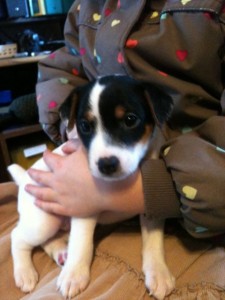Archive ∙ Back to Island Voices
February 2012
The reward of a well-planned and executed breeding program is the birth of healthy puppies. But whelping is not the end of the chores. In fact, once puppies arrive, the real work begins, and it’s also the time things can go wrong. If your lactating bitch becomes seriously ill, or if she dies, you become the caregiver to her brood. If you can find a bitch to take them on, your problems are over. If your search fails, it is up to you to rear the orphan puppies.
The Nest Box
The nest box must be designed to keep puppies warm and dry. It can be intricately made, or as simple as a cardboard pet carrier. Tall sides stop the puppies from climbing out and getting chilled. It should be closable so that pups can be in the dark.
Line the bottom of the box with towels covered with disposable diapers. Cut the elastic on the legs of the diapers so that they lie flat. You can change the diapers several times a day if needed.
The temperature of the nest box is very important. Pups die if they get chilled. An electric heating pad under half the box provides a warm spot at one end, but the pups can crawl to the cooler side if they get too warm. You can also use bottles filled with warm water put under towels at one end of the box. As soon as they turn cool, they must be refreshed.
Feeding
Puppies need optimal nutrition. Commercial formulas are preferred because they have all the nutrients puppies need. Besides fats, sugars, and proteins, they contain added amino acids to prevent the development of nutritional cataracts (opacities in the lens of the eyes). Cataracts used to be a common problem in puppies fed low quality commercial formulas and they still occur in puppies fed poorly balanced homemade formulas.
In an emergency, you can make a formula from ingredients on hand. Mix together one cup whole milk, one teaspoon salad oil, two eggs yolks and, if you have it, a drop of a multivitamin. It is not balanced and shouldn’t be used for long-term feeding.
The bottles and nipples used for human infants can be used with large breed puppies. Miniature bottles with tiny nipples are available for small pups. Warm the formula and put the nipple in the pup’s mouth. If the pup is slow to suckle, put your finger in his mouth to start him sucking, and then substitute the nipple for your finger.
Another way to get nutrition in a pup is to tube feed with a soft latex tube attached to a syringe filled with warm replacer. The tube is put in the mouth and pushed in so the pup swallows it. There is a simple way to make sure the tube is not in the lungs (milk put directly in the airway would cause aspiration pneumonia and death of the puppy).
Put a piece of tape on the tube, indicating the distance from the tip of the nose to the last rib. If you then have the tube in so that the tape mark is at the level of the nose, you must be in the stomach. It wouldn’t go that far if it was in the lungs.
Slowly depress the plunger, giving the stomach time to expand. Once the milk is discharged, crimp the tube before pulling it out to prevent milk leakage, milk that could be inhaled and enter the lungs.
Pups less than two weeks old need feeding every two to four hours. Drop to every four to six hours once they are over two weeks old. Their behavior can give clues for when they need feeding. If they are crying, it is feeding time. If they are sleeping and settled, their bellies are full. The quantity to give at each feeding varies from two milliliters (ml) for a small breed pup to six ml for a large breed pup.
To find out if you are giving enough food, use a postal or food scale. Puppies should gain 10 percent of their birth weight every day, consuming between 22 to 26 ml of formula per 100 grams body weight daily.
Some veterinarians are adamantly opposed to tube feeding. They suggest if a puppy is too weak to nurse, there are also no waves of contraction (peristalsis) in the stomach and intestines. This means milk given by tube will just sit in the stomach. Worse yet, it can go back up the esophagus and can be inhaled by the weak puppy. This can mean a fatal pneumonia. The better option, in their minds, is injections under the skin until the pup can nurse.
When the pups start biting and chewing the bottle instead of sucking (three to four weeks of age), they can be offered some pate-style canned food. You may want to mix it with a little formula at first and smear a little around the mouth to get them going. Once they are eating, solid food can be introduced.
Puppies also need help going to the bathroom. The bitch does this by licking the genital area, stimulating the pup to defecate and urinate. At the same time, she cleans the puppy. You can rub a wet gauze or a moistened cotton-tipped applicator (Q-tip) on the genital area to mimic her licking. Do this each time the puppy is fed.
No paper on pups is complete without a mention of fading puppy syndrome, which is a description, not a diagnosis. It can be applied to pups that stop eating, become chilled, and die before 12 weeks of age. They simply fade away and the mother rejects them.
Faders, if they die, should be analyzed so that a diagnosis can be made. Without knowing what the pup died from, you may lose more puppies. Once that is determined, you can treat the puppies with fluids, warmth, and specific treatment for the condition.
Treating Hypoglycemia
Neonatal pups have minimal fat reserves, so even a small time off food can result in hypoglycemia (low blood sugar). If severe, an intravenous injection of sugar, usually in the form of dextrose, is the best treatment. However, breeders can treat these pups at home if they are caught early enough.
If a pup is too weak to suckle, a warmed mixture of salt solution (Normosol or lactated Ringers) and five percent dextrose can be injected subcutaneously at a dose of one milliliter per 30 grams body weight. Alternatively, a warm nutrient/electrolyte solution can given by stomach tube every 15 to 30 minutes until the pup has the strength to suckle.
Normal Puppy Temperature and Chilling
The rectal temperature of a newborn pup ranges from 95 to 99 degrees Fahrenheit during the first week of life, climbing to 97 to 100 during the second and third weeks. By weaning time, the pup’s temperature is the same as that of an adult (roughly between 101 and 103 degrees Fahrenheit).
Chilling is a major hazard for puppies. If wet, or next to a draft or cold object, they lose heat rapidly. Chilling diminishes the drive to nurse. The lack of milk decreases their ability to produce heat and they become dehydrated. This leads to decreased heart function, poor circulation, and further chilling.
Chilled puppies are also more susceptible to infections because their infection-fighting white blood cells don’t function optimally. Bitches are reluctant to care for puppies with cool skin temperatures. They push them away and do not respond to their cries. Once a pup’s temperature drops below 90, there is little chance for revival. They become comatose, their heart rate plummets, and they die.
When treating chilled puppies, start by tube feeding with a sugar solution and then warm them by wrapping them in towels with hot water bottles. The towels prevent them getting too hot. Heat lamps are an alternative, but test the heat by putting your hand on the pup so you can feel how warm it is. You want to warm slowly. Too fast and the pup can go into shock.
For more information contact Dr. Jeff Grognet or Dr. Louise Janes at
Mid-Isle Veterinary Hospital
5-161 Fern Road West
Qualicum Beach, BC
Tel (250) 752-8969
Archive ∙ Back to Island Voices



Leave a Reply